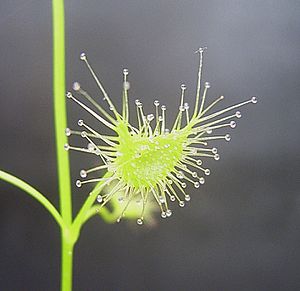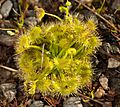Shield sundew facts for kids
Quick facts for kids Shield sundew |
|
|---|---|
 |
|
| Scientific classification | |
| Genus: |
Drosera
|
| Species: |
peltata
|
| Subspecies | |
|
|
| Synonyms | |
|
|
The shield sundew, also known as the pale sundew, is a fascinating carnivorous plant called Drosera peltata. It's a type of plant that lives for more than two years (a perennial) and grows from a special underground storage part called a tuber.
This plant is special because it can climb or spread out. Among all the sundews that grow from tubers, Drosera peltata is found in the most places. You can find it in eastern and western Australia, New Zealand, India, and many parts of Southeast Asia, including the Philippines.
The name peltata comes from Latin and means "shield shaped". This refers to the unique shape of its leaves on the stem. Scientists are still studying if Drosera peltata is one plant that looks very different in various places, or if it's a group of several closely related plants.
Tuberous sundews are a group of Drosera plants that have learned to survive dry summers. They do this by going into a resting state underground as a dormant tuber. While many tuberous sundews grow flat on the ground, D. peltata stands upright and can have simple or branching flower stalks.
Contents
What Does the Shield Sundew Look Like?
The Drosera peltata is a perennial herb that grows from an underground tuber. This tuber is usually found about 4 to 6 centimeters (about 1.5 to 2.5 inches) deep in the soil. The parts of the plant that grow above ground can be anywhere from 5 to 50 centimeters (about 2 to 20 inches) tall.
There are different forms of this plant. One type, called D. peltata subsp. auriculata, can grow quite tall, up to 50 cm. Another form, often called D. foliosa, is usually shorter, only about 5 to 10 cm tall.
Most Drosera peltata plants have a group of leaves that grow in a circle close to the ground, like a rosette. This rosette is very clear in D. foliosa. In older D. peltata subsp. auriculata plants, this rosette might be smaller.
The main stem of the plant can be simple or slightly branched. The flowers can be white or light pink. The plant's color also varies a lot. D. foliosa is usually bright green, even in direct sunlight. D. peltata subsp. auriculata often has reddish parts or can even be completely red. D. gracilis is always orange or dark red.
Where Do Shield Sundews Live?
You can often find Drosera peltata growing in open, flat areas that don't get frost. They like places with light bushes, in forests that are regrowing, and along grassy roadsides.
These plants usually grow in soft, fine clay or peaty, sandy soils. These soils are wet in winter but dry out during the summer. Because this plant is found in so many places, different forms of it grow naturally in southern, eastern, and southwestern Australia, Tasmania, and New Zealand (in Northland). They also live in Southeast Asia and India.
How Scientists Name and Classify Shield Sundews
The Drosera peltata was first described by a scientist named Carl Peter Thunberg in 1797. Because it grows in so many places and looks different, it has many different scientific names and types.
Most of these types are now considered the same species. However, two main types are still recognized as valid: D. peltata subsp. peltata and D. peltata subsp. auriculata. The auriculata type was first named by James Backhouse and described by Jules Émile Planchon in 1848. Later, Barry John Conn changed it to a subspecies of D. peltata in 1981.
Some scientists still think D. peltata subsp. auriculata is its own separate species. The main differences between these two subspecies are the shape of their seeds and whether their sepals (the leaf-like parts that protect the flower bud) are hairy.
- D. peltata subsp. peltata has egg-shaped seeds and hairy sepals.
- D. peltata subsp. auriculata has long, thin seeds and smooth sepals.
Two other forms, Drosera foliosa and Drosera gracilis, were once thought to be separate species. While they were later grouped under D. peltata, some plant experts in Tasmania and Australia now treat them as separate species again.
Drosera foliosa is different from the typical D. peltata because it has a clear rosette of large, light green leaves at its base. It also has shorter stems with many branches. The typical D. peltata has a less noticeable basal rosette and a single stem. D. foliosa mostly grows in grasslands and open woodlands with grassy areas.
Drosera gracilis looks similar to the typical D. peltata but is smaller. It has distinctively red stems and leaves. In Tasmania, it grows in wet, peaty areas. Unlike D. peltata and D. foliosa, which grow in winter and spring, D. gracilis grows in late spring and into the summer.
Growing Shield Sundews at Home
Drosera peltata is one of the easiest tuberous Drosera plants to grow. This is because it's quite forgiving when it comes to how much water and what temperature it needs.
Most tuberous Drosera plants need cool, wet winters, which is when they grow actively. They then need warmer, very dry summers, or their dormant tubers might rot. However, Drosera peltata can handle summers that are a bit wetter, making it a good choice for beginners.
Images for kids
See also
 In Spanish: Drosera peltata para niños
In Spanish: Drosera peltata para niños






